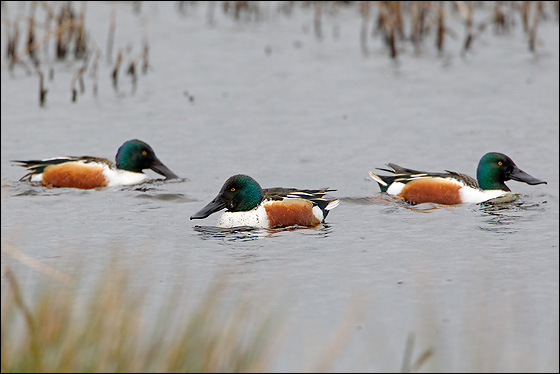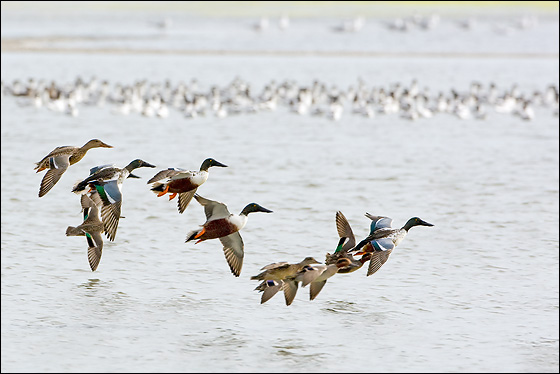Northern Shoveler (Anas clypeata)
The Shoveler’s outsize bill is its tool and its trademark. It is so long and large, and so greatly broadened at the tip that it dominates the bird’s silhouette. It seems that the Shoveler cannot swim without holding its head down with the bill resting on the water, as if it were somehow carrying a heavy burden. But of course, the bill is a special adaptation for the Shoveler’s main feeding technique, that of filtering, or sieving. The tip is broadened to allow water in as the bird moves forward, and the bill itself is voluminous to allow plenty of water to be processed in one go. On the sides of the bill, both mandibles are fitted with comb-like projections called lamellae. These are found in most ducks, but in the Shoveler they are longer and denser than usual, forming a very efficient barrier to even the smallest particles as they attempt to flow out through the sides of the bill, pumped by the tongue. Despite eating very small items, the Shoveler can consume up to 10% of its body weight in one day.
This sort of feeding requires the presence of shallow water with plenty of edible particles in suspension, so the Shoveler is drawn to productive freshwater marshes and lakes with plenty of fringing, but not stifling vegetation. It ingests all kinds of particles, including crustaceans, snails, insect larvae, seeds and plant debris. Its work is made easier if the mud can somehow be stirred up first, so a particular feature of groups of feeding Shovelers is not that they require personal space, but that they benefit from being under each other’s feet, so to speak. Birds in flocks often form a circle or circling huddle, each bird benefiting from the foot stirring of the bird swimming in front.
This sort of feeding requires the presence of shallow water with plenty of edible particles in suspension, so the Shoveler is drawn to productive freshwater marshes and lakes with plenty of fringing, but not stifling vegetation. It ingests all kinds of particles, including crustaceans, snails, insect larvae, seeds and plant debris. Its work is made easier if the mud can somehow be stirred up first, so a particular feature of groups of feeding Shovelers is not that they require personal space, but that they benefit from being under each other’s feet, so to speak. Birds in flocks often form a circle or circling huddle, each bird benefiting from the foot stirring of the bird swimming in front.
On productive waters Shovelers can find all the resources they need in one small area which means that, in contrast to most ducks, they are highly territorial in the breeding season, defending their space from all comers by pumping their head up and down in threat with the bill pointing slightly upward. The male defends both site and female, enabling the two birds to form a stronger bond than that found in most ducks. There is less infidelity or rape than in most other species, and the male sometimes remains with the female right up to the end of the incubation period.


